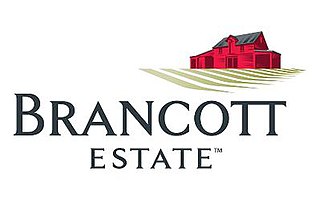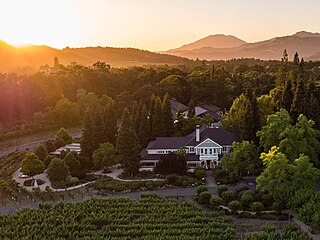

Yellow Tail (stylised [ yellow tail ] [1] ) is an Australian brand of wine produced by Casella Family Brands. Yellow Tail, as well as Casella Family Brands as a whole, are both based in Yenda, New South Wales.


Yellow Tail (stylised [ yellow tail ] [1] ) is an Australian brand of wine produced by Casella Family Brands. Yellow Tail, as well as Casella Family Brands as a whole, are both based in Yenda, New South Wales.
In 1957, the Casella family, headed by Filippo Casella and his wife Maria, emigrated from Sicily to Australia. [2] [3]
Yellow Tail was developed for the Casella family winery to enter into the bottled wine market—having previously supplied bulk wine to other wineries. [3] The Yellow Tail brand was developed in 2000 and was originally produced for the export market. It became the number one imported wine to the United States in 2011. [3] [4]
The namesake of the brand, Yellow Tail, is the yellow-footed rock wallaby (Petrogale xanthopus), a relative of kangaroos.
The vineyard produces approximately three percent of all wine and is around 540 acres (220 ha), [5] [ citation needed ] located in the Riverina, Griffith, New South Wales, Australia.
Approximately a third of the that are harvested by Yellow Tail are from their vineyard in Riverina, Australia. The rest are from other vineyards in South Eastern Australia. All Yellow Tail wines have their own specific label colour. In addition to sparkling wines, Yellow Tail makes varietal wine from the following grape varieties: Moscato, Riesling, Sémillon, Sauvignon blanc, Pinot gris, Chardonnay, Pinot noir, Merlot, Grenache, Shiraz and Cabernet sauvignon in addition to some blended wine and rosé. Each wine has different label colours; for example, the merlot label is Orange, the Shiraz has a yellow label, etc. [6]
In 2000, the Casellas joined with W.J. Deutsch & Sons, a family-owned marketing and distribution firm, in order to distribute Yellow Tail wines in the United States. In 2001, it sold 200,000 cases, a number that jumped to 2.2 million the next year. [7] In 2005, Yellow Tail sold more wine in the U.S. than all French producers combined. [8]
Yellow Tail has enjoyed market success in the United Kingdom, which, in 2000, began importing more wine from Australia than from France for the first time in history.[ citation needed ]
Various local shops around Birmingham, England were found to be selling fraudulent Yellow Tail in 2021, following complaints by a buyer. [9]

Merlot is a dark blue–colored wine grape variety that is used as both a blending grape and for varietal wines. The name Merlot is thought to be a diminutive of merle, the French name for the blackbird, probably a reference to the color of the grape. Its softness and "fleshiness," combined with its earlier ripening, make Merlot a popular grape for blending with the sterner, later-ripening Cabernet Sauvignon, which tends to be higher in tannin.

Chile has a long history in the production of wine, with roots dating back to the 16th century when the Spanish conquistadors introduced Vitis vinifera vines to the region. In the mid-19th century, French wine varieties such as Cabernet Sauvignon, Merlot, Carmenère, and Franc were introduced. During the early 1980s, the Chilean wine industry underwent a renaissance with the introduction of stainless steel fermentation tanks and the use of oak barrels for aging. This led to a rapid growth in exports as quality wine production increased. The number of wineries in Chile rose from 12 in 1995 to over 70 in 2005.

New World wines are those wines produced outside the traditional winegrowing areas of Europe and the Middle East, in particular from Argentina, Australia, Canada, Chile, Mexico, New Zealand, South Africa and the United States. The phrase connotes a distinction between these "New World" wines and those wines produced in "Old World" countries with a long-established history of wine production, essentially in Europe, most notably: France, Italy, Germany, Spain and Portugal.

The Australian wine industry is one of the world's largest exporters of wine, with approximately 800 million out of the 1.2 to 1.3 billion litres produced annually exported to overseas markets. The wine industry is a significant contributor to the Australian economy through production, employment, export, and tourism.

New Zealand wine is produced in several of its distinct winegrowing regions. As an island country in the South Pacific Ocean, New Zealand has a largely maritime climate, although its elongated geography produces considerable regional variation from north to south. Like many other New World wines, New Zealand wine is usually produced and labelled as single varietal wines, or if blended, winemakers list the varietal components on the label. New Zealand is best known for its Marlborough Sauvignon Blanc, and more recently its dense, concentrated Pinot Noir from Marlborough, Martinborough and Central Otago.

Brown Brothers Milawa Vineyard is a family-owned wine company based in Milawa, Victoria, Australia. Brown Brothers was founded in 1889 by John Francis Brown and continues to be owned and operated by his descendants on the original property. Brown Brothers makes wine from a wide range of grape varieties and into a range of styles.

Washington wine is a wine produced from grape varieties grown in the U.S. state of Washington. Washington ranks second in the United States in the production of wine. By 2017, the state had over 55,000 acres (220 km2) of vineyards, a harvest of 229,000 short tons (208,000 t) of grapes, and exports going to over 40 countries around the world from the 940+ wineries located in the state. While there are some viticultural activities in the cooler, wetter western half of the state, the majority (99.9%) of wine grape production takes place in the shrub-steppe eastern half. The rain shadow of the Cascade Range leaves the Columbia River Basin with around 8 inches (200 mm) of annual rain fall, making irrigation and water rights of paramount interest to the Washington wine industry. Viticulture in the state is also influenced by long sunlight hours and consistent temperatures.

Brancott Estate is the brand adopted since 2010 by Pernod Ricard for New Zealand's largest wine producer, formerly Montana Wines, which now operates as the New Zealand division of Pernod Ricard Winemakers. The name comes from its Brancott winery in Blenheim, and was chosen to reduce confusion in the United States market with wines from the state of Montana.

The Duckhorn Portfolio Inc. is an American wine company producing varietal labelled and blended red, white, rosé, and sparkling wines from California and Washington State. The main winery, Duckhorn Vineyards, is outside St. Helena, California.

The South Australian wine industry is responsible for more than half the production of all Australian wine. South Australia has a vast diversity in geography and climate which allows the state to be able to produce a range of grape varieties–from the cool climate Riesling variety in the Clare Valley wine region to the big, full bodied Shiraz wines of the Barossa Valley.

Victorian wine is wine made in the Australian state of Victoria. With over 600 wineries, Victoria has more wine producers than any other Australian wine-producing state but ranks third in overall wine production due to the lack of a mass bulk wine-producing area like South Australia's Riverland and New South Wales's Riverina. Viticulture has existed in Victoria since the 19th century and experienced a high point in the 1890s when the region produced more than half of all wine produced in Australia. The phylloxera epidemic that soon followed took a hard toll on the Victoria wine industry which did not fully recover till the 1950s.

New South Wales wine is Australian wine produced in New South Wales, Australia. New South Wales is Australia's most populous state and its wine consumption far outpaces the region's wine production. The Hunter Valley, located 130 km (81 mi) north of Sydney, is the most well-known wine region but the majority of the state's production takes place in the Big Rivers zone-Perricoota, Riverina and along the Darling and Murray Rivers. The wines produced from the Big Rivers zone are largely used in box wine and mass-produced wine brands such as Yellow Tail. A large variety of grapes are grown in New South Wales, including Cabernet Sauvignon, Chardonnay, Shiraz and Sémillon.
Clarendon Hills is an Australian winery founded in 1990 by Roman Bratasiuk.

British Columbia wine is Canadian wine produced in the province of British Columbia. Wines made from 100% British Columbia grapes can qualify for classification under one of British Columbia's two classification systems, depending on the variety, the winemaking techniques employed, and various other restrictions.

Henschke is a family-owned, 155-year-old Australian winery, located in Keyneton, South Australia in the Eden Valley wine region. It produces the 'Hill of Grace', one of Australia's "cult wines", and was considered Australia's second best wine by James Halliday in 2009.
Giaconda is an Australian winery in Beechworth, Victoria.

The Hunter Valley is one of Australia's wine regions. Located in the state of New South Wales and first cultivated in the early 19th century, it was one of the first Australian wine regions. As well as Hunter Valley Sémillon, the region produces wine from a variety of grapes including Shiraz, Chardonnay, Cabernet Sauvignon and Verdelho.

Cecil O. De Loach Jr. is a California grape-grower and winemaker in the Russian River Valley AVA who has contributed to the reputation and notoriety of Sonoma County viticulture.

Villa Melnik is a family-owned winery located near the village of Harsovo, about 7 km south of Melnik, Bulgaria.
Casella Family Brands is a family-owned wine company based in Australia. Its most well-known brandname is [yellow tail].